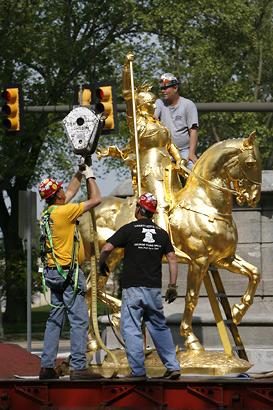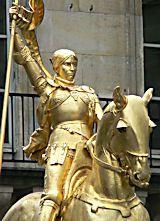 Well, not exactly Arch Street, but close enough.
Well, not exactly Arch Street, but close enough.
Many years ago, after graduating from college, I was backpacking through Europe on a Eurailpass, with a friend and also with just a few dollars in my pocket. One day in Paris, croissant in hand (yes, truly) my companion and I spied a surprising site: a colossal gilt statue of St. Joan of Arc in the Place des Pyramides. What surprised me was not that Jeanne d'Arc would be featured prominently in Paris. (She is, after all, the patron saint of France.) Rather, the statue was the same one that stands in Philadelphia's Center City, and which I would pass as a boy on the busride into town, and, later, on the way to the Jersey Shore for debauched summer weekends with friends. Seeing that statue prompted my friend's asking, "What do you know about Joan of Arc?"
Very little, I admitted, with embarrassment. After I returned home I started reading as much as I could about the Maid of Orleans. This began my interest in, and later devotion to, Joan of Arc. (I wrote about this story and my fondness for Joan not long ago in America.)
 Literally a stone's throw from the Philadelphia Museum of Art, Joan sits proudly atop her charger and looks defiantly into the distance, as if daring the stubborn English generals once again to refuse her offer for peace. The other day, my mother told me that during her first visit to France, she said to herself, "Gee, they have one just like this in Philadelphia!" (This photo of the Paris version shows her memorable expression.) How did this one end up in Philly? The French residents of the city, it turns out, donated a copy of Emmanuel Fremiet's famous work to the city in 1890. There is another copy in New Orleans, where she is rightfully called "Maid of Orleans." Philly natives, being perhaps slightly less Catholic overall than the denizens of New Orleans, sometimes call her, ahem, Joanie on a Pony.
Literally a stone's throw from the Philadelphia Museum of Art, Joan sits proudly atop her charger and looks defiantly into the distance, as if daring the stubborn English generals once again to refuse her offer for peace. The other day, my mother told me that during her first visit to France, she said to herself, "Gee, they have one just like this in Philadelphia!" (This photo of the Paris version shows her memorable expression.) How did this one end up in Philly? The French residents of the city, it turns out, donated a copy of Emmanuel Fremiet's famous work to the city in 1890. There is another copy in New Orleans, where she is rightfully called "Maid of Orleans." Philly natives, being perhaps slightly less Catholic overall than the denizens of New Orleans, sometimes call her, ahem, Joanie on a Pony.
Over the years, the cold and damp winters of Philadelphia took their toll, and for the last few years Joan was looking decidedly worse for the wear. This Thursday, though, restorers completed an ambitious four-month cleaning and regilding of Fremiet's statue of "La Pucelle," and triumphantly returned it to its place across from the Art Museum. Photos from the Philadelphia Inquirer show a gleaming new statue. A fair chunk of the $65,000 renovation (the coating is 23.5 carat gold leaf) was paid for, appropriately enough, by the French Heritage Society. Now Joan dazzles, as she did, in another way, in real life.
No matter how many times I pass the statue, I remember Joan's astonishing story; I try to see the look on her face, and I'm am always surprised, still, to see a French saint right in the middle of Philadelphia.
James Martin, SJ








My favorites are 60, 67, and 68.
Thanks for pointing her out.
The story of Joan is absolutely incredible by any standard. An 18 year old girl is given command of a national army and liberates her country in aperiod of ulimited male chauvinism. Beside her faith and willingness to obey her voices, there is another factor that is much overlooked in her story - her virginity. This was substantiated by physical examinations both before she joined the French army at Orleans and after her capture by the Burgundians. If she was otherwise, the English would have burned her as a witch, as they very much wanted to do. It would have been a politically expedient way to explain their defeats at the hand of a teenage girl. She was executed on the flimsy charge of heresy because she wore men's clothing.
Barbara Newman, a medieval historian from Northwestern University, has written that actual physical virginity was an extremely powerful talisman in the Middle Ages. In Joan's case all of her soldiers would have believed this and respected her greatly because of it; thus the reference to the "Maid" and "La Pucelle". Also she was continually faithful to Confession and reception of the Eucharist; and demand the same of them. In their eyes she must have projected an aura of invincibility. So like any charismatic war leader who leads from the front, when she said "Let's go!" they were with her all the way.